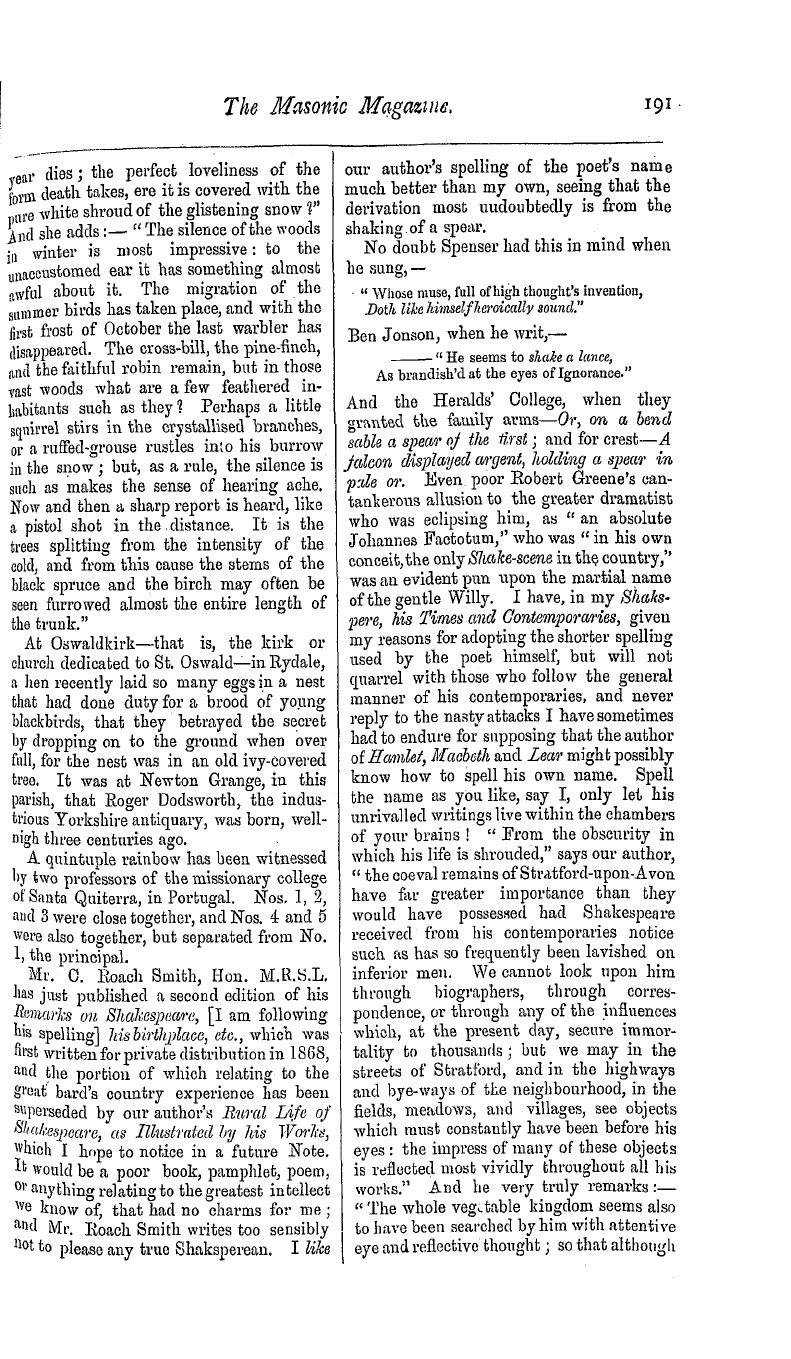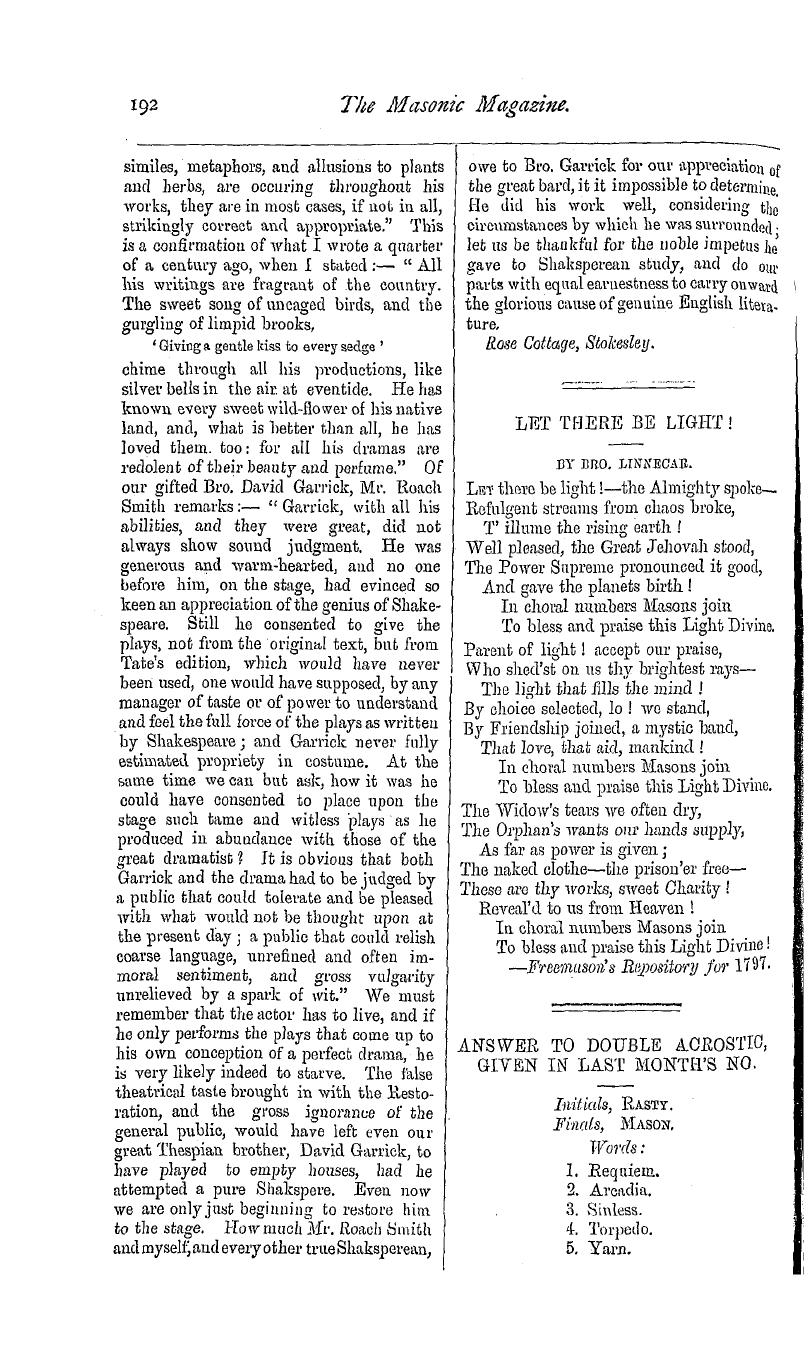-
Articles/Ads
Article WONDERS OF OPERATIVE MASONRY. ← Page 4 of 5 →
Note: This text has been automatically extracted via Optical Character Recognition (OCR) software.
Wonders Of Operative Masonry.
jiis brains , heart , eyes and tongue were buried at Rouen . In 1539 , at the Dissolution , the Abbot , " a stubborn monk , " together with two of his friars , was hanged drawn and quartered , for refusing to deliver up the Abbey to Henry VIII . Its
revenues then were equivalent to £ 20 , 000 value as estimated in 1806 . Its remains consist of a portion of the great hall , once used for parliaments , now used as a schoolroom ; some battlemeuted gateways , and the Abbey mills , which exhibit arches that
were coeval with the Abbey itself . These relics of seven centuries ago , although forming but a broken skeleton , are full of interest . DUNFERMLINE ABBEY , in Fifeshire , IS miles north-west from Edinburghwas
, founded by Malcolm Canmore , King of Scotland , in A . D . 1080 . King David I , in A . D . 1124 , introduced into it the Benedictines , or Black Monks , and raised it to the dignity of a mitred Abbey , when it became one of the most extensive and magnificent
monastic establishments in Scotland . Matthew of Westminster says : " Its boundaries were so ample that three potent sovereigns , with their retinues , might have
been accommodated with lod gings here at the same time without incommoding each other . " When King Edward of England invaded Scotland , in 1303 , he resided in the Abbey , and set it on fire when he left it , because the nobles of the kingdom assembled there and devised lots against
p him , thus " converting the Temple of the Lord into a den of thieves . " The last Abbot was George Durie , in A . D . 1530 . Its revenue was £ 2 , 513 Scots . The ruins that remain indicate its former grandeur . The Abbey was cruciform and of Norman
architecture . It was long the place of sepulture of Scottish Kings . Here were interred Malcolm Canmore , its founder ; Alexander I . ; David I ., the founder and generous patron of so many Scotch Abbeys ; and Sir Robert Bruce , the saviour his
° f country . In 1818 , Bruce ' s tomb was discovered , and in it his skeleton , wrapped in lead . The Frafery , with its J eautiful window , is extremely striking , , ls are also the massive pillars , thirteen ajid a half in circumference , which support the old Church . The new Abbey Church - -the present parish Church—is a splendid et "fice , in ornate Gothic style , with elegant
perpendicular windows . On the four sides of its tower , in capital letters four feet high , are these words : " King Robert the Bruce , '' surmounted by royal crowns . TIIOKNEY ABBEY , Cambridgeshire , 85 miles north from London , was founded by EthelwoldBishop of Winchesterin A . D .
, , 972 , for Benedictine Monks . The remains , which are incorporated into the present edifice , were erected in 112 S . When the Abbey was dissolved by Henry VIII . the greater part of it was destroyed , but the west front and nave were preserved , and
have been used since as a Church . The architecture of the front is pointed , and above the large window are nine statues of saints placed in Gothic niches , between two octagonal towers . These towers rise from the ground , and give majesty to the entire front . Thorney Abbey derived its name from the multitude of thorns which once
grew in its vicinity . At the Dissolution it possessed a revenue of £ 500 . Since Edward VI . 's time it has been a part of the Duke of Bedford's estates , and the present Duke owns 19 , 000 acres of the surrounding lands . PAISLEY ABBEY at Paisley , 8 miles
, west from Glasgow , Scotland , was founded A . D . 1163 , by Walter , High Steward of Scotland , for monks of the Clugniac order of reformed Benedictines . It was at first a Priory , but was afterwards raised to the rank of an Abbey , and richly endowedso
, that it became one of the most opulent in the Kingdom . It was burned by the English in 1307 . The present Abbey was built about 1450 , and is 265 feet in length . The interior of the nave is magnificent . Ten massiveclustered columns divide the
, aisles from the body of the fabric ; from these columns spring pointed arches , with graceful mouldings . The northern transept , although ruinous , is a fine relic of monastic grandeur . It does not appear that there was a southern transept . The
" Chronicon Clugniense , " or " Black Book of Paisley" was a history of the times , kept by the monks of this Abbey . The original is now iu the King ' s Library of St . James . Majory , daughter of King Robert Brucewho was killed while huntingwas
, , buried here , in 1316 . The Abbey is now the propeny of the Marquis of Abercorn . According to the inscription on a stone of . Melrose Abbey , Johu Moreau , its architect ;
Note: This text has been automatically extracted via Optical Character Recognition (OCR) software.
Wonders Of Operative Masonry.
jiis brains , heart , eyes and tongue were buried at Rouen . In 1539 , at the Dissolution , the Abbot , " a stubborn monk , " together with two of his friars , was hanged drawn and quartered , for refusing to deliver up the Abbey to Henry VIII . Its
revenues then were equivalent to £ 20 , 000 value as estimated in 1806 . Its remains consist of a portion of the great hall , once used for parliaments , now used as a schoolroom ; some battlemeuted gateways , and the Abbey mills , which exhibit arches that
were coeval with the Abbey itself . These relics of seven centuries ago , although forming but a broken skeleton , are full of interest . DUNFERMLINE ABBEY , in Fifeshire , IS miles north-west from Edinburghwas
, founded by Malcolm Canmore , King of Scotland , in A . D . 1080 . King David I , in A . D . 1124 , introduced into it the Benedictines , or Black Monks , and raised it to the dignity of a mitred Abbey , when it became one of the most extensive and magnificent
monastic establishments in Scotland . Matthew of Westminster says : " Its boundaries were so ample that three potent sovereigns , with their retinues , might have
been accommodated with lod gings here at the same time without incommoding each other . " When King Edward of England invaded Scotland , in 1303 , he resided in the Abbey , and set it on fire when he left it , because the nobles of the kingdom assembled there and devised lots against
p him , thus " converting the Temple of the Lord into a den of thieves . " The last Abbot was George Durie , in A . D . 1530 . Its revenue was £ 2 , 513 Scots . The ruins that remain indicate its former grandeur . The Abbey was cruciform and of Norman
architecture . It was long the place of sepulture of Scottish Kings . Here were interred Malcolm Canmore , its founder ; Alexander I . ; David I ., the founder and generous patron of so many Scotch Abbeys ; and Sir Robert Bruce , the saviour his
° f country . In 1818 , Bruce ' s tomb was discovered , and in it his skeleton , wrapped in lead . The Frafery , with its J eautiful window , is extremely striking , , ls are also the massive pillars , thirteen ajid a half in circumference , which support the old Church . The new Abbey Church - -the present parish Church—is a splendid et "fice , in ornate Gothic style , with elegant
perpendicular windows . On the four sides of its tower , in capital letters four feet high , are these words : " King Robert the Bruce , '' surmounted by royal crowns . TIIOKNEY ABBEY , Cambridgeshire , 85 miles north from London , was founded by EthelwoldBishop of Winchesterin A . D .
, , 972 , for Benedictine Monks . The remains , which are incorporated into the present edifice , were erected in 112 S . When the Abbey was dissolved by Henry VIII . the greater part of it was destroyed , but the west front and nave were preserved , and
have been used since as a Church . The architecture of the front is pointed , and above the large window are nine statues of saints placed in Gothic niches , between two octagonal towers . These towers rise from the ground , and give majesty to the entire front . Thorney Abbey derived its name from the multitude of thorns which once
grew in its vicinity . At the Dissolution it possessed a revenue of £ 500 . Since Edward VI . 's time it has been a part of the Duke of Bedford's estates , and the present Duke owns 19 , 000 acres of the surrounding lands . PAISLEY ABBEY at Paisley , 8 miles
, west from Glasgow , Scotland , was founded A . D . 1163 , by Walter , High Steward of Scotland , for monks of the Clugniac order of reformed Benedictines . It was at first a Priory , but was afterwards raised to the rank of an Abbey , and richly endowedso
, that it became one of the most opulent in the Kingdom . It was burned by the English in 1307 . The present Abbey was built about 1450 , and is 265 feet in length . The interior of the nave is magnificent . Ten massiveclustered columns divide the
, aisles from the body of the fabric ; from these columns spring pointed arches , with graceful mouldings . The northern transept , although ruinous , is a fine relic of monastic grandeur . It does not appear that there was a southern transept . The
" Chronicon Clugniense , " or " Black Book of Paisley" was a history of the times , kept by the monks of this Abbey . The original is now iu the King ' s Library of St . James . Majory , daughter of King Robert Brucewho was killed while huntingwas
, , buried here , in 1316 . The Abbey is now the propeny of the Marquis of Abercorn . According to the inscription on a stone of . Melrose Abbey , Johu Moreau , its architect ;
















































